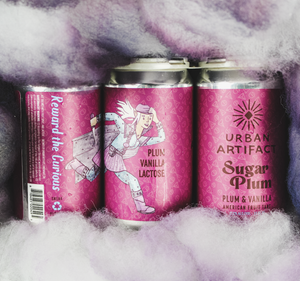Wild Culture is something we embrace fully at Urban Artifact. For us brewer’s though, the main attraction is the beer. Tart, sour & wild our beers exhibit refreshing qualities designed to push the envelope of what is more commonly understood as craft beer, while pushing our skills and creativity to the limits. No other brewery in the Ohio River Valley embraces the wild side of yeast quite like our brewer’s do, but if everyone did, how wild would it really be?
This wild pitch, we are going to teach you zymological enthusiasts how to wrangle your own yeasts. You don’t have to be a home brewer to appreciate this loose guide, those that are interested in local sourdough and other wild fermentations (sauerkraut, kimchi, pickles) can benefit from this guide as well. The basic premise is simple. You fill some jars with yeast food, set the jars out overnight, the next day collect your jars, let them ferment for a couple weeks, and profit! Now there are a couple details in there that may be beneficial to you, allow me to explain in slightly more detail (now with pictures!).
Step One: Get Your Supplies Together
Proper Planning Prevents Piss Poor Performance. The six P’s of yeast wrangling success. Not unlike the five D’s of successful dodgeball. At the very least what you’re going to need is some mason jars with lids, a sugar based yeast food source (in our case wort), cheesecloth, a container for carrying jars filled with hot liquids (such as a cardboard box) and some sanitizer (alcohol based or phosphoric acid based are both acceptable).
Step Two: Prepare Your Trap
This may be the most dangerous step of the process. Take caution when dealing with hot liquids. The first thing you want to do is prepare your yeast capturing media. In our case we use wort made from DME. You don’t want to make this too sweet, we shoot for a specific gravity of 1.035 – 1.040, which is probably equivalent to a couple tablespoons of flour or sugar in a pint of water if you want to go the sourdough route. You also want to make sure the pH is kept low, preferably between 4.0 – 4.4. We aim for a 4.3 pH, the key here though is to keep the pH below 4.5 as this inhibits enteric bacteria and mold growth, which if you are not familiar with the flavors enteric bacteria can produce, it is often equated to cheese or baby vomit. Once you have dissolved your media into hot water, place it in the mason jars and loosely seal them up with the proper self-sealing lids. You will now need to pasteurize these jars to remove any contaminants that may have snuck in during the filling process. To do this, the simple water bath method is more than adequate. Simply bring enough water to cover the jars completely to a boil, slowly set all the jars in the water, bring the water back to a boil, and boil the whole thing for at least 15 minutes. Once the boil is complete, remove the jars from the hot water bath and place them in your cardboard box for burn free carrying. At this point you are ready to go trap some yeast!
Step Three: Set Your Traps
The first thing you need to do to successfully place a yeast trap, is to put your mind in the shoes of the yeast. They float on the air all around us, land on random things on a whim, and are always on the lookout for sugar. Look for places that have some good airflow, either inside or out, as this will increase your odds of successfully capturing wild yeast and bacteria.
Furthermore, yeast are fickle creatures. Time of day, weather, temperature, all of these things have an effect on what wild cultures you are likely to catch. We prefer to set our traps out in the early evening and collect them in the mornings, while the day is at its coolest. Once you have some good locations in mind, gather your hot jars of wort, that cheesecloth from earlier and your sanitizer. Once you arrive at your desired location, take a jar and cheesecloth, spray them both down with your sanitizer and then remove the lid on the mason jar. Cover the jar with your cheesecloth and put a rubber band (or screw the metal band back on) to keep the cheesecloth in place. This will prevent any bugs or leaves from falling into your jar. Once you placed all your jars (ideally in different locations), head home and drink a good luck beer. The next day, go back to your jars (you remembered where you put them, right?) with your lids, sanitize the lids, collect the jars the raccoons didn’t get, and seal them back up. You did it! You caught some wild yeast. Take your bounty and head home, time for another celebratory beer!
Step Four: Wait
At this point, you are waiting for signs of fermentation. Make sure to keep the lids on loose, as fermentation takes off, pressure will build and if you don’t de-gas your jars they could explode. If any of your jars develop mold, either pink, green or black, throw it away. Don’t event taste it. If the jars turn gelatinous, throw them out. However, if the jars smell vaguely of fermenting beer, cloves, smoky, cabbage or some other tolerable aroma you may be in luck! Give the jars three weeks to ferment and develop and while you wait stop on down to the Urban Artifact taproom for a beer or two and talk to the brewers about your yeast adventures. After three weeks, jars that still have no signs of mold and smell decent to good need to be sampled. Most of the time, you won’t catch anything good, and some samples may even cause you to wretch, but every now and then around 15% of the time, you catch a winner. This is the jar of wild culture you have been waiting for.
Step Five: Make a Wild Beer
This is where your patience will be tested even further, but the rewards will be far greater. Brew a beer like normal and when fermentation starts to slow down, pitch your mason jar of wild cultures into the beer, put your fermentor away, and wait at least six months. For us this generally involves an oak barrel, some delicious beer and lots of time and space. The end result after all of this is something that is truly divine, a beer like no other, a beer that literally no one else in the world can replicate. Terroir is not a term commonly used to describe beer, but when you are brewing beer with wild cultures, it doesn’t get any more local than that.
Cheers,
Bret Kollmann Baker
Chief of Brewing Operations








